What resources are available?
There are several physical facilities available on campus at BYU for acoustics and structural dynamics research. As a great benefit to undergraduate and graduate students, there is a strong culture of involving interested students early in research with laboratory-quality instrumentation and the training necessary to contribute to the greater acoustics community.
We’ve highlighted a few of the more significant research capabilities in this article.
Large Anechoic Chamber
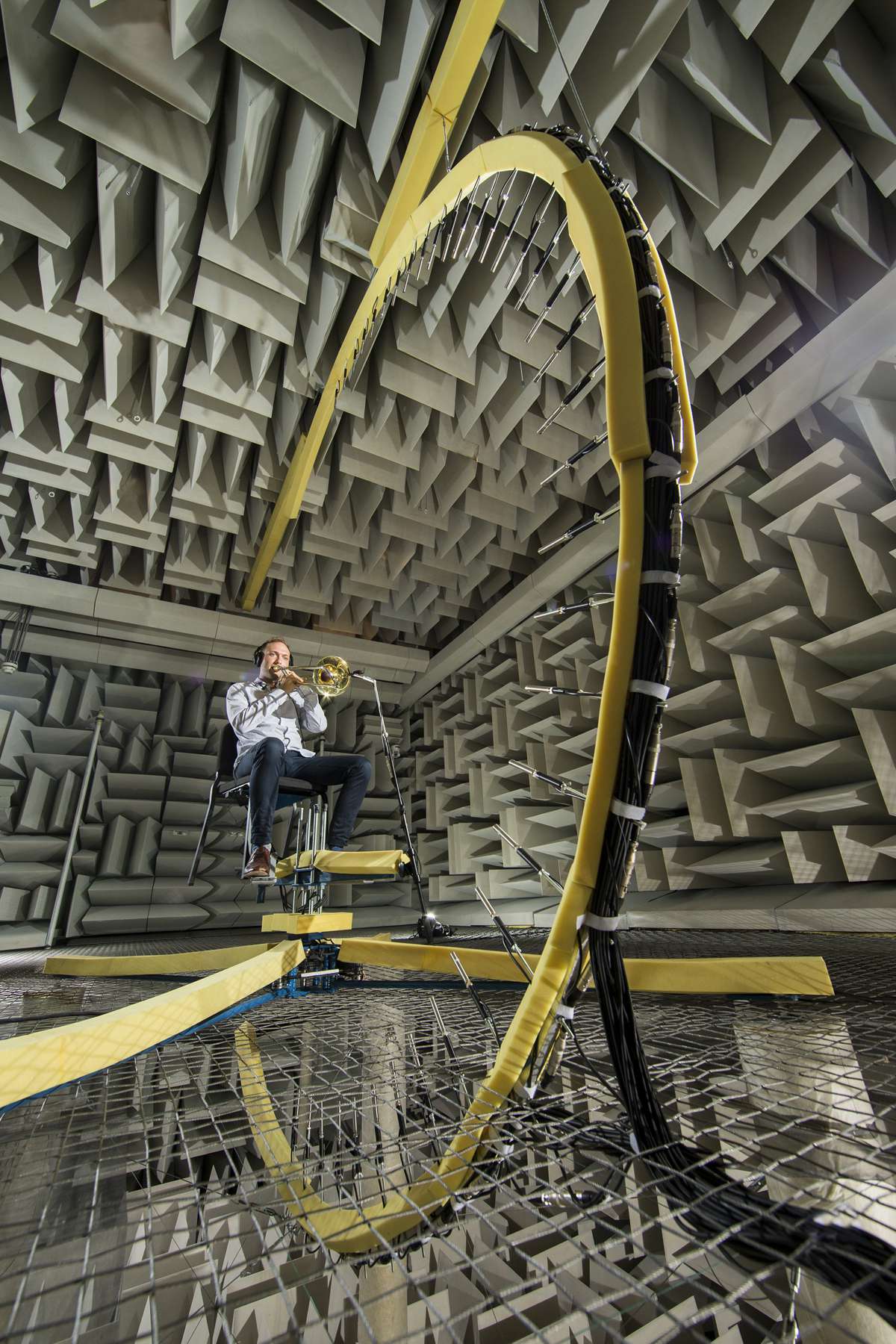
The large anechoic chamber (anechoic: free from echo) is a research facility designed to absorb acoustic reflections. In this way it simulates free-field radiation conditions as if no walls were present, thus allowing an acoustic measurement to be conducted with minimal interference from room effects. With working dimensions of 8.71 x 5.66 x 5.74 m, the room is anechoic down to approximately 80 Hz and large enough to handle a variety of experiments. Within the chamber there are several accommodations, including:
- Two-dimensional automated scanning/measurement acquisition system (third dimension of automated motion is currently under construction)
- Large hemispherical microphone array with automated rotating stand for high-resolution three-dimensional directivity measurements
- Overhead measurement boom with automated rotation/acquisition
Curious about recent experiments in the anechoic chamber? Check out the Current Research page.
Small Anechoic Chamber

In addition to the large anechoic chamber, BYU also has a smaller anechoic chamber with working dimensions of 3.00 x 2.38 x 2.59 m. This chamber is anechoic down to 150 Hz but is also anechoic in the ultrasonic frequency range as well up to at least 100 kHz (whereas the large chamber's high frequency anechoic cutoff is lower, due to the perforated metal covering on the wedges).
Variable Acoustics Chamber

The variable acoustic chamber is suited for measurements where the acoustic properties of the room response may vary. Using removable paneling, sections of the walls or ceiling can be added or removed as necessary such that various acoustic conditions can be established in the enclosure. The working dimensions of this room are 3.57 x 2.88 x 2.59 m.
Reverberation Chambers
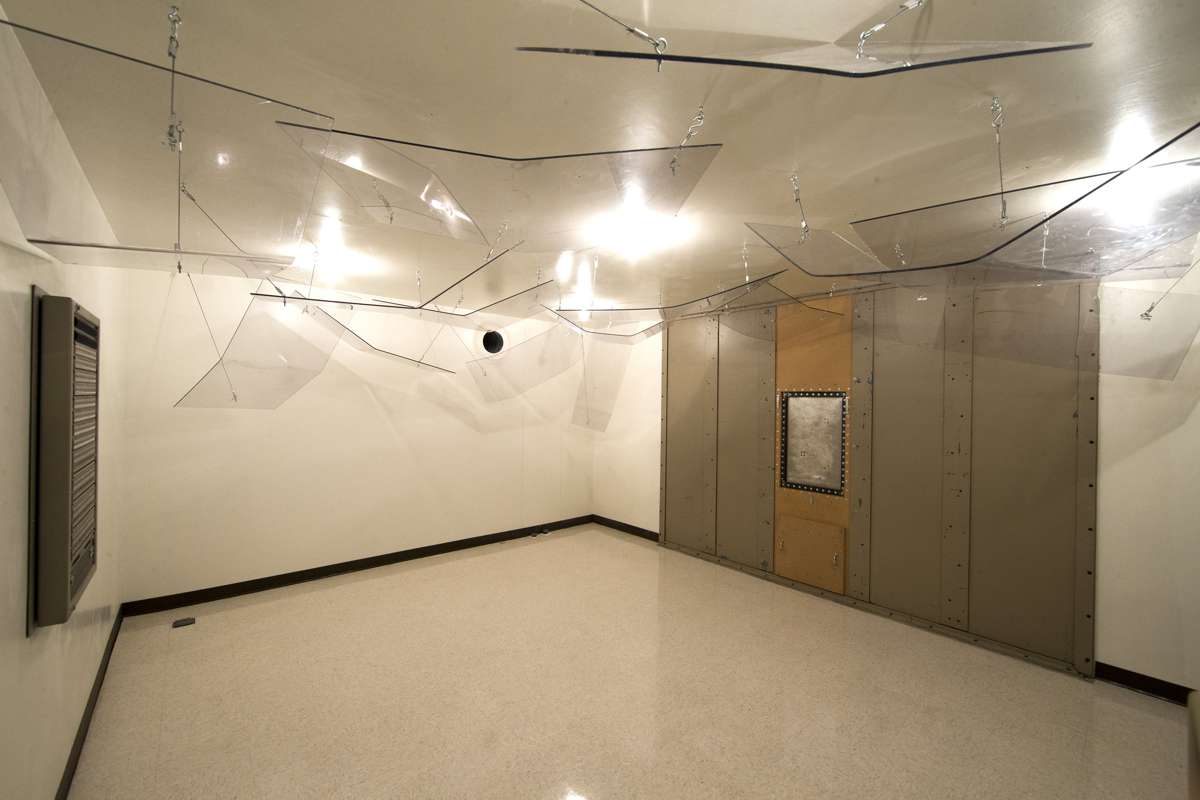
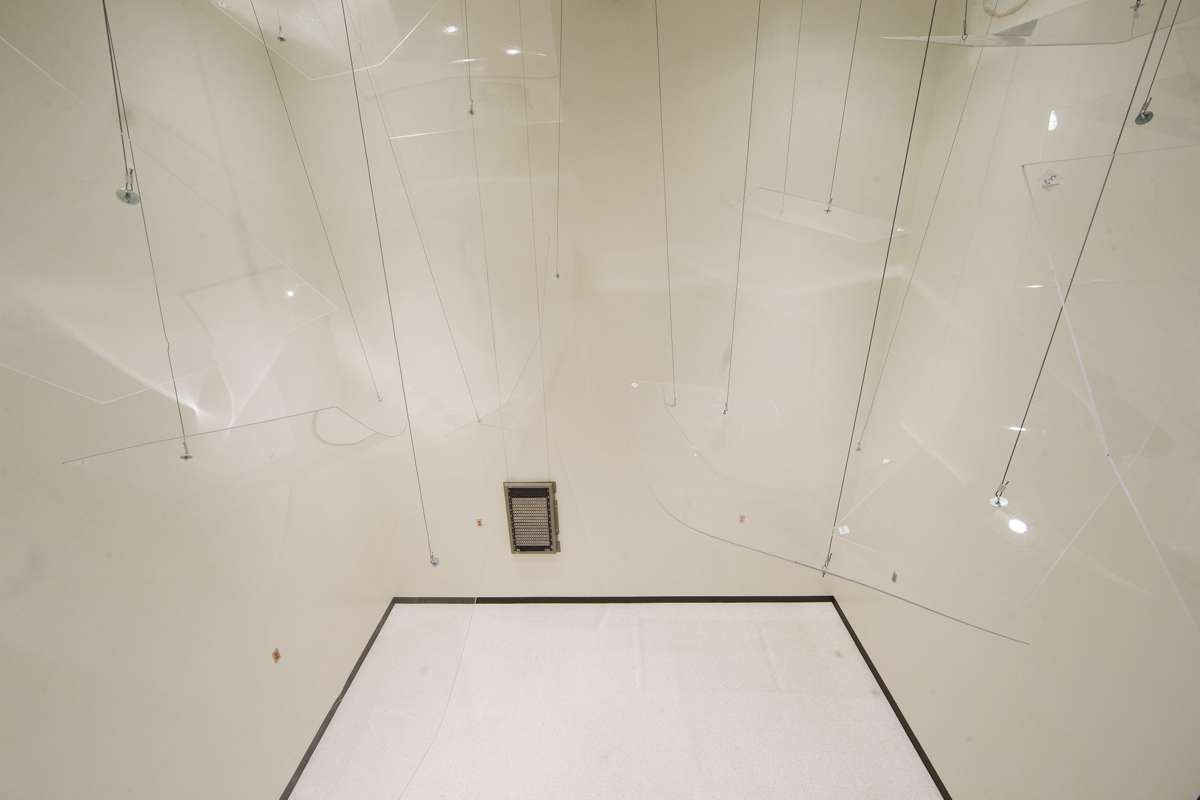
While the anechoic chambers minimize reflection sources to suit experiment needs, reverberation chambers attempt to reinforce acoustic sources to create a spatially distributed sound field. For these purposes, two reverberation chambers have been constructed with dimensions of 4.96 x 5.89 x 6.98 m (204 cubic meters) and approximately 5.69 x 4.32 x 2.49 m (61 cubic meters). These rooms are adjacent to each other and are acoustically coupled through a variable test panel (dimensions 2.44 x 3.05 m) to allow for transmission loss testing.
Underwater Acoustics Tank
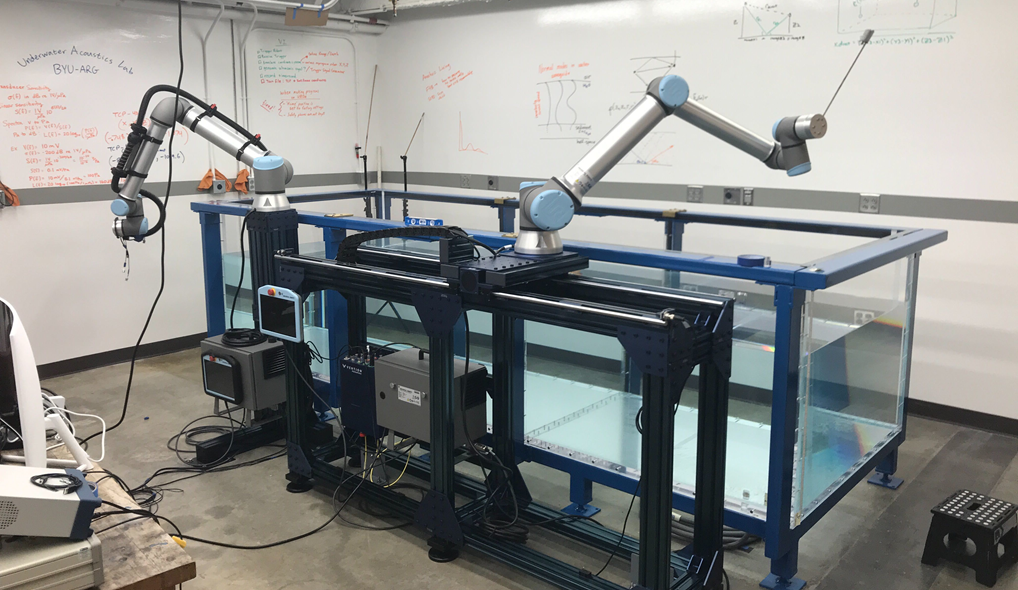
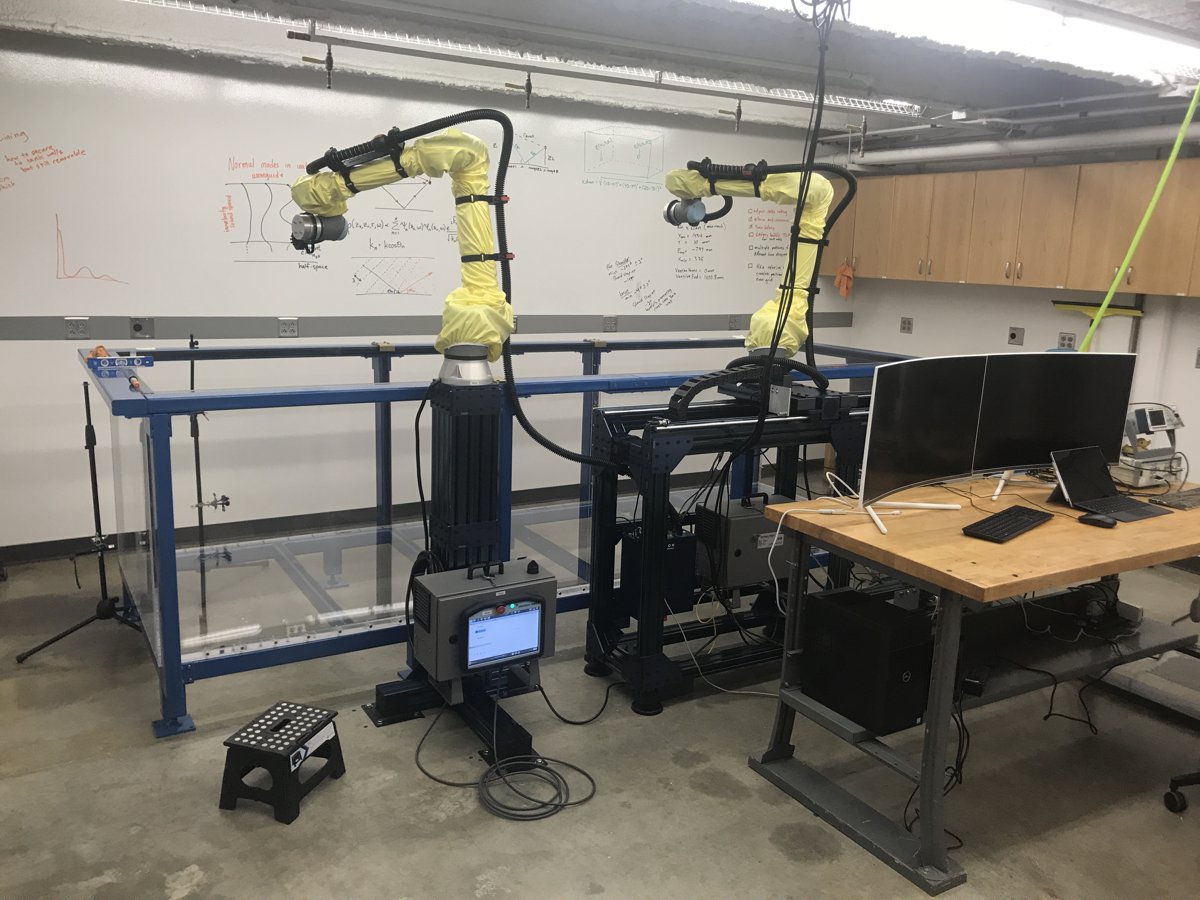
The Hydroacoustics lab contains a 1.22 m x 3.66 m x 0.92 m deep acrylic water tank capable of holding up to 1077 gallons of water. It has a Universal Robotics 3D positioning system using two UR10e robotic arms and one 7th axis extender in order to scan the dimensions of the tank with hydrophones with 0.1 mm precision. In this lab underwater acoustics can be explored for improving SONAR and studying the acoustic nature of fish or AUV (automated underwater vehicle) communication or experiments can be validated before field tests.
Inventory Listing
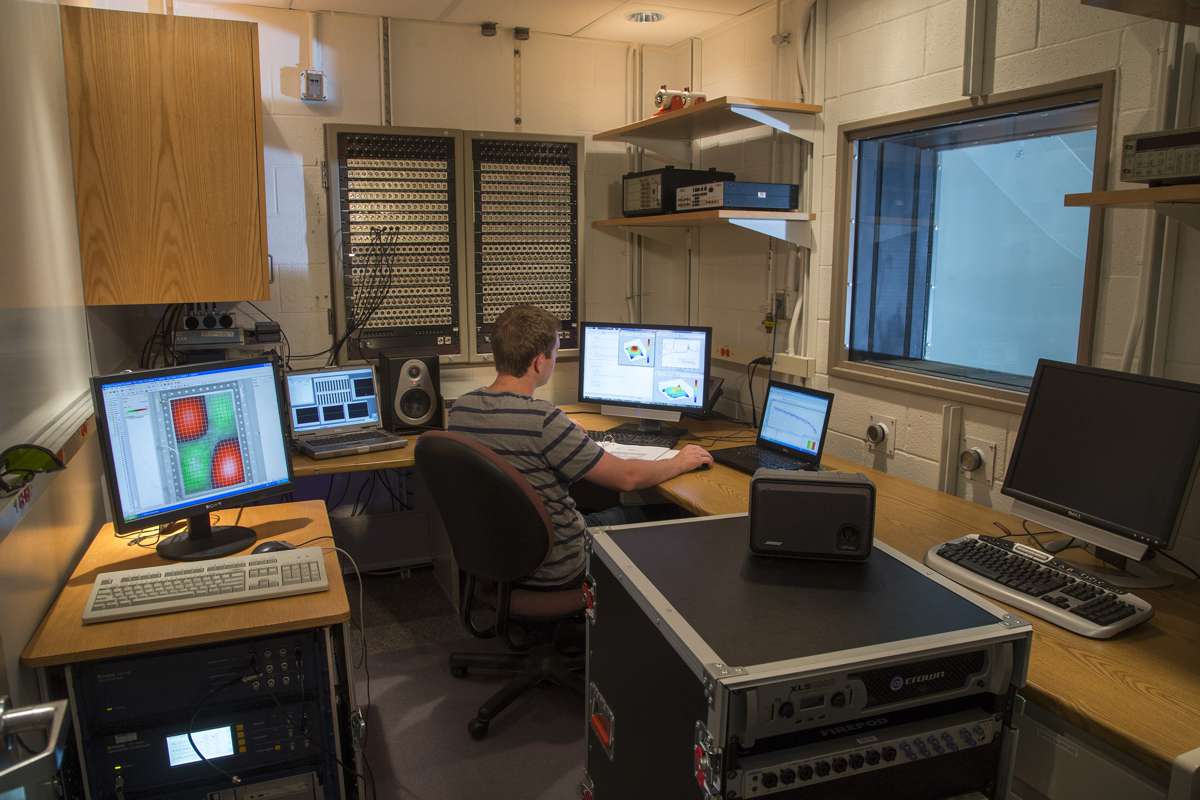
There are a number of resources available for performing the numerical analysis involved with projects. The software packages SysNoise, VitrualLab, IDEAS, CATT, EASE/EARS, Fluent, and FIDAP are available. Other fairly standard software packages, such as MATLAB and LabVIEW are also available. The research group has direct access to several PCs, and SGI workstations. Furthermore, BYU has one of the largest university owned supercomputing facilities, being ranked in the top five nationally. These supercomputers can run the SysNoise, IDEAS, and Fluent packages when needed, to take advantage of the parallel processing capabilities and faster computation times.
General purpose hardware, such as microphones, loudspeakers, signal filters, and amplifiers are also available to assist in the research. Multi-channel dynamic signal analyzers are available for general purpose measurements. Specialty analyzers are available for transducer and room acoustics measurements. A computer-controlled turntable may be used to rotate booms, sources, sensors, or arrays within chambers if required. An acoustic intensity probe is available for determining acoustic intensity in a sound field. General purpose hardware such as microphones, accelerometers, loudspeakers, shakers, and so forth are also available. A scanning laser Doppler vibrometer (SLDV) is available for noncontact structural vibration measurements.
Partial Listing of BYU Acoustical Equipment and Facilities
Chambers
- Large anechoic chamber (8.71 x 5.66 x 5.74 m working dimensions), anechoic down to approximately 80 Hz.
- Small anechoic chamber (3.00 x 2.38 x 2.59 m working dimensions), anechoic down to approximately 150 Hz (has ultrasonic capabilities).
- Large 204 m3 reverberation chamber (4.96 x 5.89 x 6.98 m working dimensions).
- Small 60 m3 reverberation chamber
- Water tank (___ x ___ x ___ m working dimensions)
Analyzers
- Data Physics SignalCalc 620 56 channel dynamic signal analyzer based on the Agilent VXI platform.
- National Instruments PXI 36-channel data acquisition system.
- National Instruments USB-6259 16 channel data acquisition system.
- Hewlett-Packard HP35670A 4 channel dynamic signal analyzer.
- Hewlett-Packard HP35670A 2 channel dynamic signal analyzer.
- SDA EASERA 2 or 8 channel analyzer.
- DRA MLSSA analyzer.
- Gold Line TEF 20 analyzer.
- SIA SMAART PC-based analyzer.
- Larson-Davis 2900B real-time analyzer.
- Three Larson-Davis 824-2541 type 1 sound level meter/real-time analyzers.
Transducers
- Over 70 type 1 precision microphones (1/8", 1/4", 1/2" and 1") with preamps and power supplies (Larson Davis, G.R.A.S., Bruel and Kjaer).
- Several directional condenser and dynamic microphones.
- Larson Davis intensity probe.
- Several prototype probes for energy density and other measurements.
- Knowles KEMAR binaural dummy head.
- Several PCB accelerometers.
- PCB impact hammer kit.
- Several powered and unpowered full-range loudspeakers, subwoofers, compression drivers, horns, etc.
- Several LDS electro-mechanical shakers.
- Several studio-grade headphones.
- Several "omnidirectional" regular polyhedral loudspeakers (RPLs), e.g., tetrahedron, hexahedron, octahedron, dodecahedron, and icosahedron sources.
Electronics
- Several instrumentation-grade signal filters.
- Several instrumentation-grade signal amplifiers.
- Computer-controlled mixers with on-board DSPs.
- Several ICP power supplies and signal conditioners.
- Several phantom to ICP power converters.
- Several power amplifiers.
- Digidesign DIGI 002 production system.
- Several digital signal processing (DSP) system boards with associated multichannel I/O and software.
- Several analog and digitizing oscilloscopes.
- Other miscellaneous devices, including arbitrary waveform generators, frequency counters, multimeters, etc.
Computers
- Several desktop PC’s and PC workstations.
- Several laptop PC’s.
- Full access to BYU supercomputing facilities.
Specialized Software
- Fundamental mathematics packages (MATLAB, Maple, Mathcad, etc.).
- LMS SYSNOISE Virtual.Lab Acoustics (acoustic finite element method and boundary element method).
- ADA EASE/EARS/AURA (Acoustic ray tracing method, image source method, auralization).
- CATT Acoustics (Acoustic ray tracing method, image source method, auralization).
- ANSYS computational analysis tools.
- FLUENT computational fluid dynamics package.
- Digidesign Pro Tools LE system with various plug-in modules.
- Several CAD packages.
- Several PC-based data recording, editing, analysis and manipulation programs.
Other Devices
- Polytec PSV 400 Scanning Laser Doppler Vibrometer (SLDV) system.
- Computer-controlled microphone positioning system for large anechoic chamber.
- Computer-controlled semicircular microphone array for large anechoic chamber.
- Computer-controlled turntable.
- Source directivity measurement arrays.
- Several impedance tubes.
- Shock-wave tube for nonlinear acoustics measurements.
- Manual Cartesian-axis directional microphone positioning system.
- Spherical coordinate laser positioning system .
- Several portable meteorological stations for indoor and outdoor sound measurements.
- Two wind tunnels.
- Optically based vibration measurement systems (Moire and electro-optic holography).